What We’re Reading this week: September 29th
 This week’s edition of What We’re Reading is guest edited by Nidhi Sharma. Nidhi is a researcher in Dominique Bergmann’s lab at Stanford University. She graduated from The University of Texas at Austin and did post-doctoral work with Dr. Kathy Barton at Carnegie Institution of Science. Other than plants, she is passionate about traveling and crafting.
This week’s edition of What We’re Reading is guest edited by Nidhi Sharma. Nidhi is a researcher in Dominique Bergmann’s lab at Stanford University. She graduated from The University of Texas at Austin and did post-doctoral work with Dr. Kathy Barton at Carnegie Institution of Science. Other than plants, she is passionate about traveling and crafting.
Protoplast swelling and hypocotyl growth depend on different auxin signaling pathways ($)
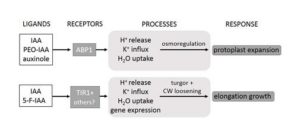 Auxin was the first phytohormone to be discovered and it has been found to have a role in nearly every aspect of plant growth and development. Auxin biology is multi-layered, as you will see in the following summaries. Auxin is regulated at the level of biosynthesis, different receptors, and domain segregation. The known auxin receptors include TIR1 (TRANSPORT INHIBITOR RESPONSE1) and AFB (AUXIN SIGNALING F-BOX) proteins that perceive auxin to induce changes in gene expression. In contrast, ABP1 (AUXIN BINDING PROTEIN1) is involved in rapid physiological response to auxin such as protoplast expansion. ABP1’s role as an auxin receptor is debated in literature; however, in this paper Dahlke et al. present evidence to support ABP1 as a receptor in the rapid non-transcriptional auxin response. Plant Physiol. 10.1104/pp.17.00733
Auxin was the first phytohormone to be discovered and it has been found to have a role in nearly every aspect of plant growth and development. Auxin biology is multi-layered, as you will see in the following summaries. Auxin is regulated at the level of biosynthesis, different receptors, and domain segregation. The known auxin receptors include TIR1 (TRANSPORT INHIBITOR RESPONSE1) and AFB (AUXIN SIGNALING F-BOX) proteins that perceive auxin to induce changes in gene expression. In contrast, ABP1 (AUXIN BINDING PROTEIN1) is involved in rapid physiological response to auxin such as protoplast expansion. ABP1’s role as an auxin receptor is debated in literature; however, in this paper Dahlke et al. present evidence to support ABP1 as a receptor in the rapid non-transcriptional auxin response. Plant Physiol. 10.1104/pp.17.00733
Review: Roles for IBA-derived auxin in plant development ($)
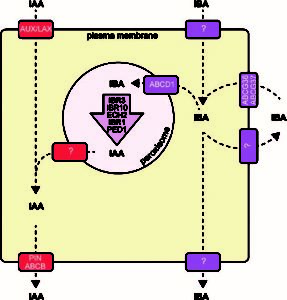 Auxin biosynthesis is a two-step process: First, tryptophan is converted to indole-3-pyruvic acid (IPyA) through the activity of the TAA1 (TRYPTOPHAN AMINOTRANSFERASE OF ARABIDOPSIS1) family of aminotransferase enzymes. IPyA is finally converted to IAA (Indole Acetic Acid) by YUCCA family of flavin monooxygenase-like enzymes. Other than tryptophan, IAA is also produced from IBA (indole-3-butyric acid). IBA itself is not perceived by TIR/AFB receptors and IBA has been genetically shown to act through its conversion to IAA. In this review, Frick and Strader describe the mechanism of IBA conversion, transport, and role in shoot and root development, and outstanding quetions about IBA biology. J. Exp. Bot. 10.1093/jxb/erx298
Auxin biosynthesis is a two-step process: First, tryptophan is converted to indole-3-pyruvic acid (IPyA) through the activity of the TAA1 (TRYPTOPHAN AMINOTRANSFERASE OF ARABIDOPSIS1) family of aminotransferase enzymes. IPyA is finally converted to IAA (Indole Acetic Acid) by YUCCA family of flavin monooxygenase-like enzymes. Other than tryptophan, IAA is also produced from IBA (indole-3-butyric acid). IBA itself is not perceived by TIR/AFB receptors and IBA has been genetically shown to act through its conversion to IAA. In this review, Frick and Strader describe the mechanism of IBA conversion, transport, and role in shoot and root development, and outstanding quetions about IBA biology. J. Exp. Bot. 10.1093/jxb/erx298
BLADE-ON-PETIOLE proteins act in an E3 ubiquitin ligase complex to regulate PHYTOCHROME INTERACTING FACTOR 4 abundance
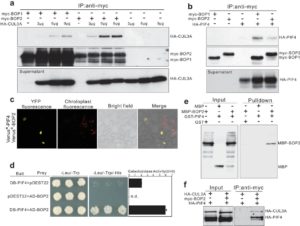 Plants need light not only for photosynthesis but also for light dependent development (called photomorphogensis). PHYTOCHROME INTERACTING FACTOR (PIF) proteins accumulate in dark to negatively regulate photomorphogensis. PIFs get degraded via 26S proteasome pathway in response to light e.g., PIF4 is known to be targeted and destabilized through polyubiquitination, but the identity of the E3 ligase complex has been unknown. Zhang et al. investigated the nature of the E3 ligase complex for PIF4 degradation and find BLADE-ON-PETIOLE (BOP) genes physically interact with the E3 ubiquitin ligase CULLIN3 to target PIF4 for polyubiquitination and subsequently degradation in response to light and temperature. eLife DOI: 10.7554/eLife.26759
Plants need light not only for photosynthesis but also for light dependent development (called photomorphogensis). PHYTOCHROME INTERACTING FACTOR (PIF) proteins accumulate in dark to negatively regulate photomorphogensis. PIFs get degraded via 26S proteasome pathway in response to light e.g., PIF4 is known to be targeted and destabilized through polyubiquitination, but the identity of the E3 ligase complex has been unknown. Zhang et al. investigated the nature of the E3 ligase complex for PIF4 degradation and find BLADE-ON-PETIOLE (BOP) genes physically interact with the E3 ubiquitin ligase CULLIN3 to target PIF4 for polyubiquitination and subsequently degradation in response to light and temperature. eLife DOI: 10.7554/eLife.26759
Cytokinin-auxin crosstalk in the gynoecial primordium ensures correct domain patterning
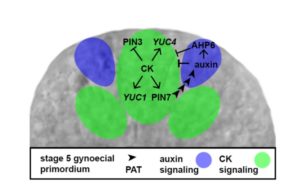 The phytohormones auxin and cytokinin (CK) work either antagonistically or synergistically to regulate several critical development pathways such as meristem formation and maintenance. Müller et al. show similar crosstalk between auxin and CK in controlling early gynoecium patterning. Using TCSn::GFP and DR5:RFP respectively, they show that CK and auxin function in exclusive domain in the gynoecium primordium, suggesting complementary signaling domains. Exogenous CK induces and endogenous CK is required to activate YUCCA auxin biosynthesis genes and the auxin transporter PIN7. This intricate hormone crosstalk is crucial for hormone homeostasis and domain specification. Plant Physiol. 10.1104/pp.17.00805
The phytohormones auxin and cytokinin (CK) work either antagonistically or synergistically to regulate several critical development pathways such as meristem formation and maintenance. Müller et al. show similar crosstalk between auxin and CK in controlling early gynoecium patterning. Using TCSn::GFP and DR5:RFP respectively, they show that CK and auxin function in exclusive domain in the gynoecium primordium, suggesting complementary signaling domains. Exogenous CK induces and endogenous CK is required to activate YUCCA auxin biosynthesis genes and the auxin transporter PIN7. This intricate hormone crosstalk is crucial for hormone homeostasis and domain specification. Plant Physiol. 10.1104/pp.17.00805
Mechanical regulation of organ asymmetry in leaves
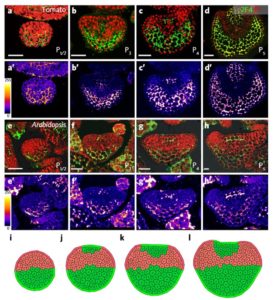 The mystery of asymmetry is a fundamental question in biology. Plants produce asymmetric shapes in many organs e.g., primordial cells on the leaf epidermis which undergo asymmetric divisions to define stomatal stem cells that ultimately form mature stomata. This asymmetric polarity of cells is governed by specific gene-expression and mechanical influences. Similarly, the dorso-ventral polarity (abaxial-adaxial) in leaves is regulated by specific gene expression. In this paper, Qi at al. provide evidence for effect of mechanical stress during development that outlines biological shapes. Nature Plants 10.1038/s41477-017-0008-6
The mystery of asymmetry is a fundamental question in biology. Plants produce asymmetric shapes in many organs e.g., primordial cells on the leaf epidermis which undergo asymmetric divisions to define stomatal stem cells that ultimately form mature stomata. This asymmetric polarity of cells is governed by specific gene-expression and mechanical influences. Similarly, the dorso-ventral polarity (abaxial-adaxial) in leaves is regulated by specific gene expression. In this paper, Qi at al. provide evidence for effect of mechanical stress during development that outlines biological shapes. Nature Plants 10.1038/s41477-017-0008-6
Functional identification of MdPIF1 as a Phytochrome Interacting Factor in apple ($)
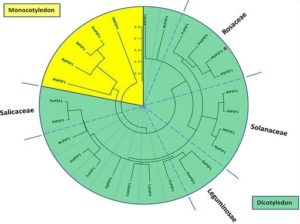 PIF1 is a well-studied negative regulator of phytochrome-mediated photomorphogenesis in Arabidopsis. Zhou et al. cloned the PIF1 cDNA from apple (Malus domestica) and characterized the gene itself. Interestingly, the bHLH and active Phytochrome B binding (APB) motif is conserved in MdPIF1 and a complementation assay of MdPIF1 into a pil5 mutant suggests MdPIF1 is biologically functional. Similar to Arabidopsis PIF1, MdPIF1 is also involved in seed germination in apples. Plant Physiol. Biochem. 10.1016/j.plaphy.2017.08.027
PIF1 is a well-studied negative regulator of phytochrome-mediated photomorphogenesis in Arabidopsis. Zhou et al. cloned the PIF1 cDNA from apple (Malus domestica) and characterized the gene itself. Interestingly, the bHLH and active Phytochrome B binding (APB) motif is conserved in MdPIF1 and a complementation assay of MdPIF1 into a pil5 mutant suggests MdPIF1 is biologically functional. Similar to Arabidopsis PIF1, MdPIF1 is also involved in seed germination in apples. Plant Physiol. Biochem. 10.1016/j.plaphy.2017.08.027
The effect of bisphenol A on growth, pigment composition and photosystem II activity of Arabidopsis thaliana
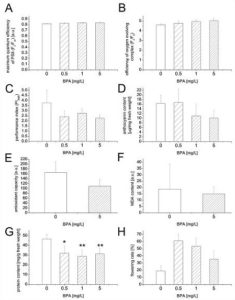 Many of the plastic consumables we have at home contain synthetic chemical BPA (Bisphenol A). In 1930, a UK scientist discovered that BPA weakly mimics the human hormone estrogen. It has also been found that tiny amount of BPA can leach out of plastic (Stanford University). Thus, there has been a heightened interest on the safety of BPA in our food as consumers and it has also piqued interest in scientific studies. The plastic waste in our environment exposes BPA to plants. Does BPA have an effect on plant growth and development? This paper describes the effect of BPA on toxicity and development of Arabidopsis thaliana. Acta Biochimica Polonica 10.18388/abp.2017_1626.
Many of the plastic consumables we have at home contain synthetic chemical BPA (Bisphenol A). In 1930, a UK scientist discovered that BPA weakly mimics the human hormone estrogen. It has also been found that tiny amount of BPA can leach out of plastic (Stanford University). Thus, there has been a heightened interest on the safety of BPA in our food as consumers and it has also piqued interest in scientific studies. The plastic waste in our environment exposes BPA to plants. Does BPA have an effect on plant growth and development? This paper describes the effect of BPA on toxicity and development of Arabidopsis thaliana. Acta Biochimica Polonica 10.18388/abp.2017_1626.



